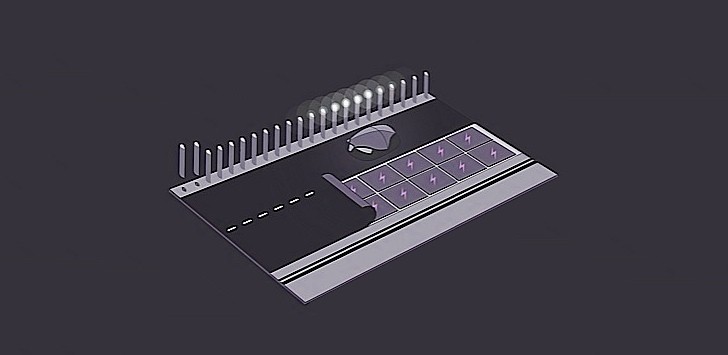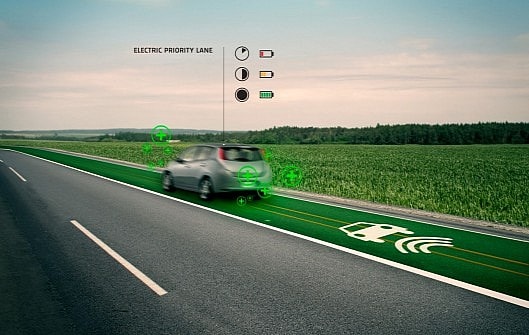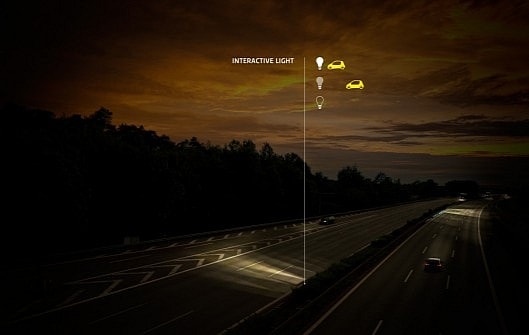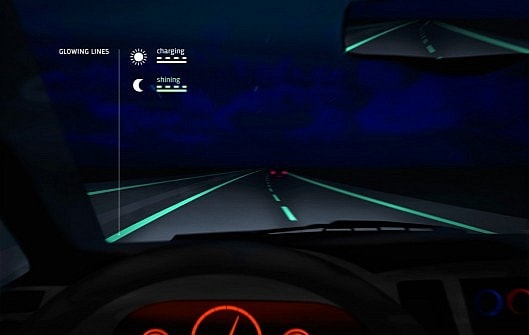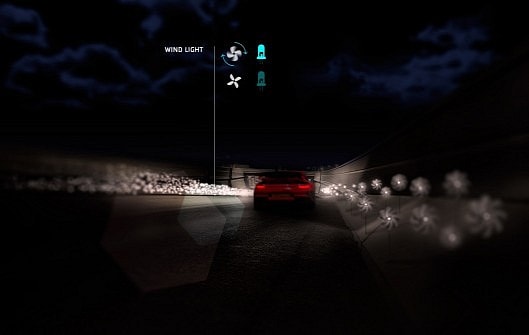Roads have not really evolved at all since they reached the point of being smooth and well-marked, which was decades ago. We have moved on from gravel and cobblestone to smooth tarmac, and that’s pretty much it. However, car have evolved a great deal and the biggest change is yet to come full-force - self driving cars. Now, along with the cars which are on the verge of becoming smartphones on wheels, roads must evolve as well.
Today’s roads have very little actual technology incorporated into their design and function, so what could be added to keep them up to date with the latest technological developments? Well, from interactive lighting, to glow-in-the-dark markings to self-sufficiency in terms of energy production, we will be discussing it all here. There are many types of technologies which could be incorporated, but we’ll begin with what we say is the most important new feature which will soon be applied to actual roads.
Since EVs are becoming increasingly popular, while their batteries are still much too weak to assure an anxiety-free drive on the highway, the induction charging (wireless) will begin to be incorporated into one of the lanes, so that these all-electric cars will be able to drive on the highway without using their on-board batteries at all, as they will get their juice straight from underneath the road surface. The idea of inductive charging is simple, and various companies and universities are testing the system now, in view of future mass implementation.
The introduction of such lanes on major highways would reduce the strain on the automakers to come up with increasingly powerful (and expensive) battery technologies, allowing them to even shrink the size of the battery packs used, making the cars lighter and more efficient in the process. It would open up a whole new realm of possibilities for both drivers and automakers - it would really be a win-win situation.
Now, the problem of illumination, which is nowadays dealt with in a very energy-inefficient way could and should be looked at. A Dutch company, called Studio Roosegraade, detailed a very interesting system of ‘interactive lighting’, which uses sensors to only light up the area around the vehicle, as it drives by, thus eliminating the need for all of the lights to be on all the time.
As a car approaches, the sensors detect it, and dimly light up the furthest visible point, then as a car approaches the given point, the lights are turned on to maximum power, and the next light is turned on, while the one the car has just passed gets dimmed down, and so on. It is such a beautifully-simple idea and it could be done even without the use of actual advanced technology.
This system could be correlated with what is called ‘wind light’, which would involve some sort of small wind turbines and generators, placed alongside the road surface, which aside from being powered by the actual wind, would also create electricity under the influence of the draught created by speeding passing cars. All of that ‘artificial wind’ is wasted, yet it is sufficiently powerful to make a highway self-sufficient, as well as power auxiliary buildings such as service stations and, of course, the illumination.
Another problem which could be addressed with the use of advanced techniques is the way in which drivers are warned of weather conditions. While large LED screens placed on the side of the road are useful, in giving drivers all sorts of useful information about traffic and weather conditions up ahead, it simply wouldn’t be feasible to keep placing such screens frequently enough to give drivers genuinely accurate information.
So, the idea of using special paints on the road surface, which light up under certain atmospheric conditions (snow, ice or just very low temperatures) would be much more useful and accurate, in letting drivers know where dangerous spots may be. Such techniques could be used to great effect on highways, as some portions of highway may be OK to be driven on at the legal limit, while others may not be - all in the space of a few hundreds of meters.
In areas where highways intertwine into huge networks of highways, and congestion is a problem, traffic density monitoring sensors could very efficiently re-route traffic onto less congested roads, in real time, and with no need for an actual human to do the work. Drivers could get this information either via their onboard sat-nav units, or screens placed at specific locations, where going on an alternate route is still an option. The same system could also warn drivers of accidents or roadworks.
This is not rocket science, and all of this can be achieved with relatively basic technology, and while the cost of anything roadworks-related is high, these systems are not expensive enough to deter investors from trying to get them implemented. It isn’t a problem of technology, but more a problem of money and lack of information on the road administrators’ part. However, if these people become better informed, we should see all of these systems begin to take hold, within the next five years - in ten years time we may even call them ‘commonplace’.
The only real downside to all of this is the fact that everything will become more complicated, and it seems that no matter how much we try to make our technology 100% safe, a glitch or error always seems to find its way into ‘the system’, somehow. The first of these systems to be implemented may fail at times, but the more there are, the better and more reliable they will be, and the cheaper they will be, thus allowing more roads to benefit from their use.
Since EVs are becoming increasingly popular, while their batteries are still much too weak to assure an anxiety-free drive on the highway, the induction charging (wireless) will begin to be incorporated into one of the lanes, so that these all-electric cars will be able to drive on the highway without using their on-board batteries at all, as they will get their juice straight from underneath the road surface. The idea of inductive charging is simple, and various companies and universities are testing the system now, in view of future mass implementation.
The introduction of such lanes on major highways would reduce the strain on the automakers to come up with increasingly powerful (and expensive) battery technologies, allowing them to even shrink the size of the battery packs used, making the cars lighter and more efficient in the process. It would open up a whole new realm of possibilities for both drivers and automakers - it would really be a win-win situation.
Now, the problem of illumination, which is nowadays dealt with in a very energy-inefficient way could and should be looked at. A Dutch company, called Studio Roosegraade, detailed a very interesting system of ‘interactive lighting’, which uses sensors to only light up the area around the vehicle, as it drives by, thus eliminating the need for all of the lights to be on all the time.
As a car approaches, the sensors detect it, and dimly light up the furthest visible point, then as a car approaches the given point, the lights are turned on to maximum power, and the next light is turned on, while the one the car has just passed gets dimmed down, and so on. It is such a beautifully-simple idea and it could be done even without the use of actual advanced technology.
This system could be correlated with what is called ‘wind light’, which would involve some sort of small wind turbines and generators, placed alongside the road surface, which aside from being powered by the actual wind, would also create electricity under the influence of the draught created by speeding passing cars. All of that ‘artificial wind’ is wasted, yet it is sufficiently powerful to make a highway self-sufficient, as well as power auxiliary buildings such as service stations and, of course, the illumination.
Another problem which could be addressed with the use of advanced techniques is the way in which drivers are warned of weather conditions. While large LED screens placed on the side of the road are useful, in giving drivers all sorts of useful information about traffic and weather conditions up ahead, it simply wouldn’t be feasible to keep placing such screens frequently enough to give drivers genuinely accurate information.
So, the idea of using special paints on the road surface, which light up under certain atmospheric conditions (snow, ice or just very low temperatures) would be much more useful and accurate, in letting drivers know where dangerous spots may be. Such techniques could be used to great effect on highways, as some portions of highway may be OK to be driven on at the legal limit, while others may not be - all in the space of a few hundreds of meters.
In areas where highways intertwine into huge networks of highways, and congestion is a problem, traffic density monitoring sensors could very efficiently re-route traffic onto less congested roads, in real time, and with no need for an actual human to do the work. Drivers could get this information either via their onboard sat-nav units, or screens placed at specific locations, where going on an alternate route is still an option. The same system could also warn drivers of accidents or roadworks.
This is not rocket science, and all of this can be achieved with relatively basic technology, and while the cost of anything roadworks-related is high, these systems are not expensive enough to deter investors from trying to get them implemented. It isn’t a problem of technology, but more a problem of money and lack of information on the road administrators’ part. However, if these people become better informed, we should see all of these systems begin to take hold, within the next five years - in ten years time we may even call them ‘commonplace’.
The only real downside to all of this is the fact that everything will become more complicated, and it seems that no matter how much we try to make our technology 100% safe, a glitch or error always seems to find its way into ‘the system’, somehow. The first of these systems to be implemented may fail at times, but the more there are, the better and more reliable they will be, and the cheaper they will be, thus allowing more roads to benefit from their use.
